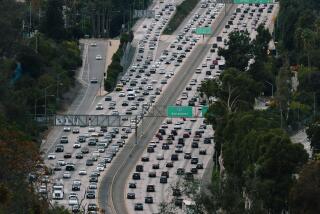ARCHITECTURE : Interstate 405-10 Interchange: Where Roadway Turns Into Art
- Share via
Freeways can be beautiful. Detach yourself from preconceptions about the ugliness of concrete and the evil of automobile traffic and look up at the sweeping arcs of the interchange at the 405 and the 10. You just might begin to see the grandest piece of public sculpture in West Los Angeles.
The function of this massive concrete sculpture is to get as many cars as possible as efficiently as possible from one freeway to the other. This intersection performs that function with an elegance unmatched by most others around town.
The best place to view this public artwork is either from Sawtelle or Sepulveda boulevards, the two roads that parallel the 405.
From Sepulveda looking north, the tall swoops that connect the 405 south to the 10 east cut through the sky with an arc that seems to defy gravity.
From Sawtelle looking south, you can see the various layers of freeway arranging themselves in a dense composition, from the highest connectors to the bass tone of the 10 as it continues its straight march to the sea. Looking north on that same road, the connectors are tilted as if to display the cars to you as they crisscross on their speeding paths.
If you want the full sculptural effect, stand directly under the intersection in the Caltrans maintainence yard that sits between densely planted berms. There, it all comes together in curves that balance each other in direction and height, rising effortlessly out of dramatically sloped berms and held down by slender columns. Architects often dream of what buildings might be like if they didn’t have to worry about gravity--the Caltrans engineers seem well on their way to figuring it out.
At least they did back in mid-1960s, when this and some of the other more dramatic interchanges in the Southland were constructed. These days, they have to work with tighter earthquake standards, and they seem to worry about making their interchanges look like something other than concrete connections.
One of the beauties of the 405/10 interchange is the incredible cleanliness of line it exhibits: column meets ramp with no transition, and ramp and rail are integrated into a single piece of concrete. More recent construction, like those around the Century Freeway, use clunky splayed connections, and the concrete is incised in an attempt at decoration, which only calls attention to itself. To find true beauty in freeways these days, you have to go to Houston, where the new Sam Houston Tollway makes our freeways look like overweight dinosaurs.
The real way to experience Los Angeles’ best interchange, of course, is by driving on it. There is nothing like the sweeping panorama of the city that you get while transitioning from the 10 east to the 405 north. On the 10, the massed ramps create a gateway to either the Westside or the rest of the city. On the 405, the lower interchange opens you up for the gradual ascent up the Sepulveda Pass, or prepares you for the tighter landscape and traffic massing around the airport area.
In the end, this knot of concrete is just the biggest thing in the area. It is a monument, a gateway and a hymn to speed that reveals much about our city, whether you like it or not. It poses itself almost surreally against the neighborhood around it, provides a kinetic experience as you drive on it, and has, during the last 25 years, transformed the neighborhoods it almost destroyed during its construction.
If it’s true that we don’t make particularly good public buildings or spaces in Los Angeles, at least we have some great freeway intersections.
West Hollywood-based Aaron Betsky teaches and writes about architecture.
More to Read
Sign up for Essential California
The most important California stories and recommendations in your inbox every morning.
You may occasionally receive promotional content from the Los Angeles Times.










